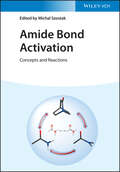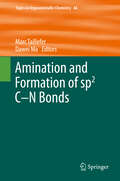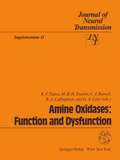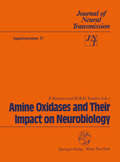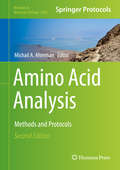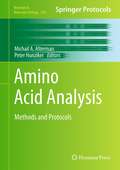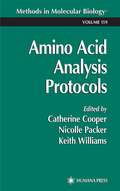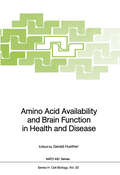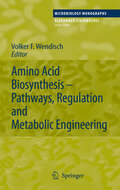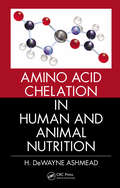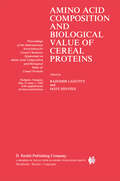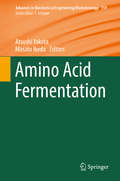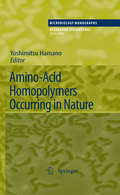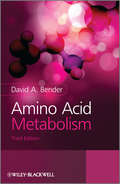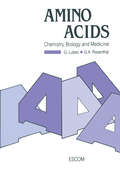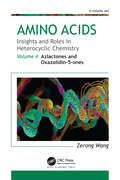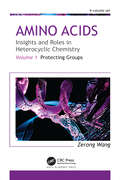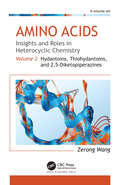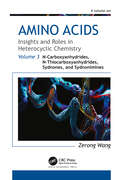- Table View
- List View
Amide Bond Activation: Concepts and Reactions
by Michal SzostakAmide Bond Activation Comprehensive resource on the pivotal role of the amide bond in organic synthesis This book provides the reader with insight into the advances that have taken place in the field of amide bond activation. It focuses on both the fundamental structural properties of the amide bond and the synthetic reactions mediated by transition-metals. By discussing amide bond activation in terms of modern organic synthesis, the reader is provided with a thorough overview of the area and its crucial role in forging carbon-carbon and carbon-heteroatom bonds. Sample topics discussed within the work include: Cross-coupling of amides Amide bond activation by twisting and nitrogen pyramidalization Electrophilic amide bond functionalization Transition metal-catalyzed radical reactions of amides Amide bond esterification, hydrolysis and transamidation Classical bridged lactams and anomeric amides Computational studies of amide C-N bond activation Cross-coupling of esters by C-O activation The book is immensely valuable to synthetic chemists in academia and the pharmaceutical industry who wish to gain an in-depth understanding of the concept of amide bond activation.
Amide Bond Activation: Concepts and Reactions
by Michal SzostakAmide Bond Activation Comprehensive resource on the pivotal role of the amide bond in organic synthesis This book provides the reader with insight into the advances that have taken place in the field of amide bond activation. It focuses on both the fundamental structural properties of the amide bond and the synthetic reactions mediated by transition-metals. By discussing amide bond activation in terms of modern organic synthesis, the reader is provided with a thorough overview of the area and its crucial role in forging carbon-carbon and carbon-heteroatom bonds. Sample topics discussed within the work include: Cross-coupling of amides Amide bond activation by twisting and nitrogen pyramidalization Electrophilic amide bond functionalization Transition metal-catalyzed radical reactions of amides Amide bond esterification, hydrolysis and transamidation Classical bridged lactams and anomeric amides Computational studies of amide C-N bond activation Cross-coupling of esters by C-O activation The book is immensely valuable to synthetic chemists in academia and the pharmaceutical industry who wish to gain an in-depth understanding of the concept of amide bond activation.
Amination and Formation of sp2 C-N Bonds (Topics in Organometallic Chemistry #46)
by Marc Taillefer and Dawei MaPalladium-Catalyzed sp2C–N Bond Forming Reactions: Recent Developments and Applications. Metal-catalyzed C(sp2)-N bond formation.- Recent Developments in Recyclable Copper Catalyst Systems for C−N Bond Forming Cross-Coupling Reactions Using Aryl Halides and Arylboronic Acids. Assembly of N-containing heterocycles via Pd and Cu-catalyzed C-N bond formation reactions. Copper-Catalyzed C(aryl)-N Bond Formation.
Amine Oxidases: Proceedings of the 5th International Amine Oxidase Workshop, Galway, Ireland, August 22–25, 1992 (Journal of Neural Transmission. Supplementa #41)
by K. F. Tipton M. B. H. Youdim C. J. Barwell B. A. Callingham G. A. LylesMonoamine oxidase plays a major role in the pathogenesis of neuropsychiatric disorders including depressive illness, Parkinson´s disease and Alzheimer´s disease. The new generation of selective monoamine oxidase inhibitors, devoid of major side effects, has found a prominent place in the treatment of these diseases. Some of these drugs may have neuroprotective activity with prospects for treating progressive neurodegenerative diseases. The volume presents a collection of research papers on monoamine oxidase and its inhibitors. The topic is treated from the point of view of chemistry, biochemistry, pharmacology, physiology, neurology and psychiatry. The book serves as a quick and comprehensive reference source for obtaining the most up to date information.
Amine Oxidases and Their Impact on Neurobiology: Proceedings of the 4th International Amine Oxidases Workshop, Würzburg, Federal Republic of Germany, July 7–10, 1990 (Journal of Neural Transmission. Supplementa #32)
by Peter Riederer Moussa B. H. YoudimAmino Acid Analysis: Methods and Protocols (Methods in Molecular Biology #2030)
by Michail A. AltermanAmino Acid Analysis (AAA) is an integral part of analytical biochemistry. In a relatively short time, the variety of AAA methods has evolved dramatically with more methods shifting to the use of mass spectrometry (MS) as a detection method; another new aspect is miniaturization. However, most importantly, AAA in this day and age should be viewed in the context of Metabolomics as a part of Systems Biology. Amino Acid Analysis: Methods and Protocols, Second Edition presents a broad spectrum of all available methods allowing readers to choose the method that best suits their particular laboratory set-up and analytical needs. In this volume, readers can find chapters describing general, as well as specific approaches to the sample preparation. A number of chapters describe specific applications of AAA in clinical chemistry, as well as in food analysis, microbiology, marine biology, drug metabolism, even archaeology. Separate chapters are devoted to the application of AAA for protein quantitation and chiral AAA. Written in the highly successful Methods in Molecular Biology series format, chapters contain introductions to their respective topics, lists of the necessary materials and reagents, step-by-step, readily reproducible laboratory protocols, and notes on troubleshooting and avoiding known pitfalls.Authoritative and accessible, Amino Acid Analysis: Methods and Protocols, Second Edition provides crucial techniques that can be applied across multiple disciplines by anyone involved in biomedical research or life sciences.
Amino Acid Analysis: Methods and Protocols (Methods in Molecular Biology #828)
by Michail A. Alterman and Peter HunzikerAmino Acid Analysis (AAA) is an integral part of analytical biochemistry. In a relatively short time, the variety of AAA methods has evolved dramatically with more methods shifting to the use of mass spectrometry (MS) as a detection method. Another new aspect is miniaturization. However, most importantly, AAA in this day and age should be viewed in the context of Metabolomics as a part of Systems Biology. Amino Acid Analysis: Methods and Protocols presents a broad spectrum of all available methods allowing for readers to choose the method that most suits their particular laboratory set-up and analytical needs. In this volume, a reader can find chapters describing general as well as specific approaches to the sample preparation. A number of chapters describe specific applications of AAA in clinical chemistry as well as in food analysis, microbiology, marine biology, drug metabolism, even archeology. Separate chapters are devoted to the application of AAA for protein quantitation and chiral AAA. Written in the highly successful Methods in Molecular Biology™ series format, chapters contain introductions to their respective topics, lists of the necessary materials and reagents, step-by-step, readily reproducible laboratory protocols, and notes on troubleshooting and avoiding known pitfalls. Authoritative and accessible, Amino Acid Analysis: Methods and Protocols provides crucial techniques that can be applied across multiple disciplines by anyone involved in biomedical research or life sciences.
Amino Acid Analysis Protocols (Methods in Molecular Biology #159)
by Catherine Cooper Nicolle Packer and Keith WilliamsAmino Acid Availability and Brain Function in Health and Disease (Nato ASI Subseries H: #20)
by Gerald HuetherThe picture on the following page is being reproduced here, at the request of the partici pants in the Advanced Research Workshop "Amino Acid Availability and Brain Function in Health and Disease". I displayed this limewood carving, entitled "Neurochemistry", during my closing remarks to this extraordinarily stimulating and productive workshop so ably organized by my collaborator Dr. Gerald Huether. We scientists need two sturdy legs to carry us through all the twists and turns of our academic careers. We should also have, as it were, a reserve leg handy, to help us stay upright when this career ends. My "third leg" is wood carving. The idea for "Neurochemis try" came to me in the plane carrying me to the congress of the International Neuro chemical Society in Jerusalem. We need the hands for our meticulous experimental work, and at least one ear to listen to the messages our neurons send us. A few years ago it would have been premature to hold a workshop on this subject. Now, however, the time was just right to allow an overview of the status of current re search, and to point out the promising new openings it has created. There is no doubt that the book to be published as a result of this workshop will be, for the next years at least, the standard text on the subject. Hearty thanks to all speakers for their brilliant con tributions and to all participants for the lively, uninhibited and stimulating discussion.
Amino Acid Biosynthesis – Pathways, Regulation and Metabolic Engineering (Microbiology Monographs #5)
by Volker F. WendischThis book presents the current knowledge of fundamental as well as applied microbiology of amino acids. Coverage details the amino acid biosynthetic pathways, their genetic and biochemical regulation, transport of amino acids and genomics of producing microorganisms. The book also examines the metabolic engineering of microorganisms for the biotechnological production of amino acids for use as pharmaceuticals and as food and feed additives.
Amino Acid Chelation in Human and Animal Nutrition
by H. DeWayne AshmeadAlthough introduction of amino acid chelates in mineral nutrition initially met considerable skepticism and controversy, the greater absorption and bioavailability of amino acid chelated minerals compared to nonchelated minerals have been well-documented for decades. Amino Acid Chelation in Human and Animal Nutrition compiles published chemical, nu
Amino Acid Composition and Biological Value of Cereal Proteins: Proceedings of the International Association for Cereal Chemistry Symposium on Amino Acid Composition and Biological Value of Cereal Proteins
by Radomir Lásztity Máté HidvegiCereals belong to the most important elements in the history of mankind. From the beginning of agriculture, cereals have been by far the most important staple food in the world. Although the cereal consumption decreased to a low level in the developed countries in Europe and North America, in the devel oping countries over two-thirds of the calorie and protein intake is based on cereals. A substantial quantity of cereals goes indirectly into food via feed to animals. Generally, cereal proteins are classified as proteins of lower biological value because of shortage in lysine and some other essential amino acids. Recent developments in the de termination and evaluation of the biological value of proteins and protein mixtures suggest that the oversimplified earlier evaluation of cereal proteins must be reviewed. This book contains the edited proceedings of the Inter national Symposium on "Amino Acid Composition and Biological Value of Cereal Proteins", held in Budapest, Hungary, Hay 31- June 1, 1983, under the sponsorship of the International Association for Cereal Chemistry, Hungarian Scientific Society for Food Industry and Grain Trust, Hungary, with supplemental invited contributions. Scientists (biologist, plant breeders, farmers, chemists, biochemists, engineers, food technologists and nutritionists) from 17 countries presented and reviewed, along with partici pants from 20 countries, the recent methodology and trends in the determination of the biological value of cereal proteins, v the amino acid composition of cereal proteins and factors in fluencing the composition and the role of cereal proteins in nutrition and animal feeding.
Amino Acid Fermentation (Advances in Biochemical Engineering/Biotechnology #159)
by Atsushi Yokota Masato IkedaThis book presents the latest findings on amino acid fermentation and reviews the 50-year history of their development. The book is divided into four parts, the first of which presents a review of amino acid fermentation, past and present. The second part highlights selected examples of amino acid fermentation in more detail, while the third focuses on recent advanced technologies. The last part introduces readers to several topics for future research directions in amino acid production systems. A new field, “amino acid fermentation”, was created by the progress of academic research and industrial development. In 1908, the Japanese researcher Kikunae Ikeda discovered glutamate as an Umami substance. Then a new seasoning, MSG (monosodium glutamate), was commercialized. Although glutamate was extracted from the hydro-lysate of wheat or soybean in the early days, a new production method was subsequently invented – “fermentation” – in which glutamate is produced from sugars such as glucose by a certain bacterium called Corynebacterium. The topic of this volume is particularly connected in a significant way with biochemical, biotechnological, and microbial fields. Both professionals in industry and an academic audience will understand the importance of this volume.
Amino-Acid Homopolymers Occurring in Nature (Microbiology Monographs #15)
by Yoshimitsu HamanoMicroorganisms are capable of producing a wide variety of biopolymers. Homopolymer peptides, which are made up of only a single type of amino acid, are far less ubiquitous. The only two amino-acid homopolymers known to occur in nature are presented in this volume. Poly-epsilon-L-lysine is a polycationic peptide and exhibits antimicrobial activity against a wide spectrum of microorganisms. It is both safe and biodegradable and is therefore used as a food preservative in several countries. In addition, there has been great interest in medical and other applications of poly-lysine and its derivatives. In contrast, poly-gamma-glutamic acid is an unusual anionic polypeptide. It is also water soluble, biodegradable, edible, non-toxic and non-immunogenic and can be chemically modified to introduce various drugs. These features are very useful for pharmaceutical and biomedical applications. Poly-glutamic acid is also a highly attractive as a food ingredient.
Amino Acid Metabolism
by David A. BenderAmino Acid Metabolism, 3rd Edition covers all aspects of the biochemistry and nutritional biochemistry of the amino acids. Starting with an overview of nitrogen fixation and the incorporation of inorganic nitrogen into amino acids, the book then details other major nitrogenous compounds in micro-organisms, plants and animals. Contents include a discussion of the catabolism of amino acids and other nitrogenous compounds in animals, and the microbiological reactions involved in release of nitrogen gas back into the atmosphere. Mammalian (mainly human) protein and amino acid requirements are considered in detail, and the methods that are used to determine them. Chapters consider individual amino acids, grouped according to their metabolic origin, and discussing their biosynthesis (in plants and micro-organisms for those that are dietary essentials for human beings), major metabolic roles (mainly in human metabolism) and catabolism (again mainly in human metabolism). There is also discussion of regulatory mechanisms for all these metabolic pathways, and of metabolic and genetic diseases affecting the (human) metabolism of amino acids. Throughout the book the emphasis is on the nutritional importance of amino acids, integration and control of metabolism and metabolic and other disturbances of relevance to human biochemistry and health. Completely revised edition of this comprehensive text covering all the latest findings in amino acid metabolism research Written by an authority in the field Covers new advances in structural biology Clear illustrations of all structures and metabolic pathways Full list of recommended further reading for each chapter and bibliography of papers cited in the text
Amino Acid Metabolism
by David A. BenderAmino Acid Metabolism, 3rd Edition covers all aspects of the biochemistry and nutritional biochemistry of the amino acids. Starting with an overview of nitrogen fixation and the incorporation of inorganic nitrogen into amino acids, the book then details other major nitrogenous compounds in micro-organisms, plants and animals. Contents include a discussion of the catabolism of amino acids and other nitrogenous compounds in animals, and the microbiological reactions involved in release of nitrogen gas back into the atmosphere. Mammalian (mainly human) protein and amino acid requirements are considered in detail, and the methods that are used to determine them. Chapters consider individual amino acids, grouped according to their metabolic origin, and discussing their biosynthesis (in plants and micro-organisms for those that are dietary essentials for human beings), major metabolic roles (mainly in human metabolism) and catabolism (again mainly in human metabolism). There is also discussion of regulatory mechanisms for all these metabolic pathways, and of metabolic and genetic diseases affecting the (human) metabolism of amino acids. Throughout the book the emphasis is on the nutritional importance of amino acids, integration and control of metabolism and metabolic and other disturbances of relevance to human biochemistry and health. Completely revised edition of this comprehensive text covering all the latest findings in amino acid metabolism research Written by an authority in the field Covers new advances in structural biology Clear illustrations of all structures and metabolic pathways Full list of recommended further reading for each chapter and bibliography of papers cited in the text
Amino Acids: Chemistry, Biology and Medicine
by G. Lubec Gerald A. RosenthalThere is little wonder in the fact that the investigation of amino acids is of fundamental interest to scientists from so many diversified fields. If amino acids were only basic constituents of enzymes as well as structural and other proteins, this property alone would elevate them to real scientific importance. Added to this role, however, is their ability to serve as building blocks for the production of many classes of secondary metabolites. They can support the biosynthesis of a myriad of natural products including nonprotein amino acids, cyanogenic glycosides, phar macologically active alkaloids, certain phenols, purines and pyrimidines, nucleic acids, condensed tannins, lignins and other metabolites. The approximately twenty or so amino (and imino) acids that comprise proteins are well known; less familiar are what is now approaching 600 nonprotein amino acids that have been isolated and characterized from plant, fungal or animal sources. Investigations of the protein amino acids have proven of outstanding value in enhancing our understanding of a variety of physiological and neurological topics that affect human health and well being. Amino acids are used to probe inhibitory and excitatory transmission receptors in the brain. They contribute to our understanding of epilepsy, development of anti-epileptic drugs, production of novel y-arninobutyric acid uptake inhibitors, and acute and chronic neurodegenera tive disorders.
Amino Acids: Volume 4: Azlactones and Oxazolidin-5-ones
by Zerong WangThis first-of-its-kind four-volume book series provides up-to-date information on α-amino acids, detailing the potential challenges in working with α-amino acids, the protecting groups for the carboxyl, side chain groups of the amino acids, and the most popular heterocyclic compounds that are originating from α-amino acids. These heterocyclic compounds include hydantoins, thiohydantoins (including 2-thiohydantoins, 4-thiohydantoins, 2,4-dithiohydantoins), 2,5-diketopiperazines, N-carboxyanhydrides, N-thiocarboxyanhydrides, sydnones, sydnonimines, azlactones, pseudoazlactones, and oxazolidin-5-ones. This is the first resource to comprehensively present all the heterocycles that can be directly prepared from α-amino acids. In addition, almost all kinds of synthetic methods for a particular type of heterocycles from α-amino acids are included, along with the detailed mechanistic discussions and experimental procedures. Volume 4: Azlactones and Oxazolidin-5-ones discusses two types of simple heterocycles that can be prepared from α-amino acids, i.e., azlactones (also known as oxazolones, 4-unsaturated azlactones included) and oxazolidin-5-ones. These heterocyclic compounds behave differently in both biological and chemical properties, and their biological activities are presented in a well-organized manner in this volume. The other volumes in the set are: Volume 1: Protecting Groups Volume 2: Hydantoins, Thiohydantoins, and 2,5-Diketopiperazines Volume 3: N-Carboxyanhydrides, N-Thiocarboxyanhydrides, and Sydnones All together, this unique 4-volume set thoroughly covers the two types of heterocyclic compounds that are originated from alpha-amino acids, providing carefully compiled updated information with detailed examples. The author has shared many thoughtful insights based on his strong background in physical organic chemistry. The volumes will be highly valuable for graduate students and senior students, as well as for professors and researchers working in the field of medicinal and pharmaceutical chemistry, organic chemistry, organic synthesis, heterocycles, and proteins and peptides.
Amino Acids: Volume 1: Protecting Groups
by Zerong WangThis is the first volume of a first-of-its-kind four-volume book set that provides readers with up-to-date information on α-amino acids, the potential challenges in working with α-amino acids, the protecting groups for the carboxyl, amino and side chain groups of the amino acids, and the most popular heterocyclic compounds that are originating from α-amino acids. These heterocyclic compounds include hydantoins, thiohydantoins (including 2-thiohydantoins, 4-thiohydantoins, 2,4-dithiohydantoins), 2,5-diketopiperazines, N-carboxyanhydrides, N-thiocarboxyanhydrides, sydnones, sydnonimines, azlactones, pseudoazlactones, and oxazolidin-5-ones. This is the first resource to comprehensively collect all the heterocycles that can be directly prepared from α-amino acids. In addition, almost all kinds of synthetic methods for a particular type of heterocycles from α-amino acids are included, along with the detailed mechanistic discussions and experimental procedures. Volume 1: Protecting Groups collects and discusses the 260 protecting groups relating to amino acids, which have been organized by carboxyl group, amino group, and side chain group. The conditions to introduce these protecting groups as well as their deprotecting procedures have also been incorporated, along with the physical properties, solvent effects, and temperature effects on the solubility of amino acids. It presents the solubility of glycine and phenylalanine in a variety of solvent systems to show the impact on amino acid, where glycine generally represents the polar amino acid whereas phenylalanine represents the amino acid of non-polar side chain. The other volumes include: Volume 2: Hydantoins, Thiohydantoins, and 2,5-Diketopiperazines Volume 3: N-Carboxyanhydrides, N-Thiocarboxyanhydrides, and Sydnones Volume 4: Azlactones and Oxazolidin-5-ones All together, this unique 4-volume set thoroughly covers the two types of heterocyclic compounds that are originated from alpha-amino acids, providing carefully compiled updated information with detailed examples. The author has shared many thoughtful insights based on his strong background in physical organic chemistry. The volumes will be highly valuable for graduate students and senior students, as well as for professors and researchers working in the field of medicinal and pharmaceutical chemistry, organic chemistry, organic synthesis, heterocycles, and proteins and peptides.
Amino Acids: Volume 2: Hydantoins, Thiohydantoins, and 2,5-Diketopiperazines
by Zerong WangThis is the second volume of a first-of-its-kind four-volume book set that provides readers with up-to-date information on α-amino acids, the potential challenges in working with α-amino acids, the protecting groups for the carboxyl, amino and side chain groups of the amino acids, and the most popular heterocyclic compounds that are originating from alpha-amino acids. These heterocyclic compounds include hydantoins, thiohydantoins (including 2-thiohydantoins, 4-thiohydantoins, 2,4-dithiohydantoins), 2,5-diketopiperazines, N-carboxyanhydrides, N-thiocarboxyanhydrides, sydnones, sydnonimines, azlactones, pseudoazlactones, and oxazolidin-5-ones. This is the first resource to comprehensively collect all the heterocycles that can be directly prepared from α-amino acids. In addition, almost all kinds of synthetic methods for a particular type of heterocycles from alpha-amino acids are included, along with the detailed mechanistic discussions and experimental procedures. In Volume 2: Hydantoins, Thiohydantoins, and 2,5-Diketopiperazines compiles the three IUPAC accepted nomenclature systems for heterocyclic compounds, which will be very useful for readers working in the heterocyclic chemistry field for giving synthesized molecules their correct names. In addition, three groups of heterocyclic compounds, i.e., hydantoins, thiohydantoins (including 2-thiohydantoin, 4-thiohydantoin and 2,4-dithiohydantoin), and 2,5-diketopiperazines, have been organized with updated literature information. Particularly, all three groups of heterocyclic compounds have demonstrated many important biological activities, particularly anticancer and antibacterial activities. On the other hand, these three groups of heterocycles can be applied as substrates to make other chemical derivatives, particularly novel unnatural amino acids. All their reactivities have been compiled and updated. The other volumes include: Volume 1: Protecting Groups Volume 3: N-Carboxyanhydrides, N-Thiocarboxyanhydrides, and Sydnones Volume 4: Azlactones and Oxazolidin-5-ones All together, this unique 4-volume set thoroughly covers the two types of heterocyclic compounds that are originated from alpha-amino acids, providing carefully compiled updated information with detailed examples. The author has shared many thoughtful insights based on his strong background in physical organic chemistry. The volumes will be highly valuable for graduate students and senior students, as well as for professors and researchers working in the field of medicinal and pharmaceutical chemistry, organic chemistry, organic synthesis, heterocycles, and proteins and peptides.
Amino Acids: Volume 3: N-Carboxyanhydrides, N-Thiocarboxyanhydrides, Sydnones, and Sydnonimines
by Zerong WangThis is the third volume of a first-of-its-kind four-volume book set that provides readers with up-to-date information on α-amino acids, the potential challenges in working with α-amino acids, the protecting groups for the carboxyl, amino and side chain groups of the amino acids, and the most popular heterocyclic compounds that are originating from α-amino acids. These heterocyclic compounds include hydantoins, thiohydantoins (including 2-thiohydantoins, 4-thiohydantoins, 2,4-dithiohydantoins), 2,5-diketopiperazines, N-carboxyanhydrides, N-thiocarboxyanhydrides, sydnones, sydnonimines, azlactones, pseudoazlactones, and oxazolidin-5-ones. This is the first resource to comprehensively collect all the heterocycles that can be directly prepared from α-amino acids. In addition, almost all kinds of synthetic methods for a particular type of heterocycles from α-amino acids are included, along with the detailed mechanistic discussions and experimental procedures. Volume 3: N-Carboxyanhydrides, N-Thiocarboxyanhydrides, and Sydnones presents up-to-date detailed information on two types of heterocyclic compounds that originate from alpha-amino acids: NCAs/NTAs and sydnones/sydnonimines. The volume also covers the more than 10 initiating systems for NCA monomers to undergo the ring-opening polymerization, which are very useful for the readers in order to make living polypeptides/polypeptoids. In addition, the method to characterize these prepared polypeptides/polypeptoids is also included. Particularly, two modern mass spectrometric techniques (MALDI-TOF and ESI-TOF) have been explained with detailed examples, where the elucidation of molecular weight of protein based on the ESI-TOF spectra has been given with a practical example as well as the theory that it is based on, a unique feature of the volume. The other volumes in the set are: Volume 1: Protecting Groups Volume 2: Hydantoins, Thiohydantoins, and 2,5-Diketopiperazines Volume 4: Azlactones and Oxazolidin-5-ones All together, this unique 4-volume set thoroughly covers the two types of heterocyclic compounds that are originated from alpha-amino acids, providing carefully compiled updated information with detailed examples. The author has shared many thoughtful insights based on his strong background in physical organic chemistry. The volumes will be highly valuable for graduate students and senior students, as well as for professors and researchers working in the field of medicinal and pharmaceutical chemistry, organic chemistry, organic synthesis, heterocycles, and proteins and peptides.
Amino Acids: Volume 2: Hydantoins, Thiohydantoins, and 2,5-Diketopiperazines
by Zerong WangThis is the second volume of a first-of-its-kind four-volume book set that provides readers with up-to-date information on α-amino acids, the potential challenges in working with α-amino acids, the protecting groups for the carboxyl, amino and side chain groups of the amino acids, and the most popular heterocyclic compounds that are originating from alpha-amino acids. These heterocyclic compounds include hydantoins, thiohydantoins (including 2-thiohydantoins, 4-thiohydantoins, 2,4-dithiohydantoins), 2,5-diketopiperazines, N-carboxyanhydrides, N-thiocarboxyanhydrides, sydnones, sydnonimines, azlactones, pseudoazlactones, and oxazolidin-5-ones. This is the first resource to comprehensively collect all the heterocycles that can be directly prepared from α-amino acids. In addition, almost all kinds of synthetic methods for a particular type of heterocycles from alpha-amino acids are included, along with the detailed mechanistic discussions and experimental procedures. In Volume 2: Hydantoins, Thiohydantoins, and 2,5-Diketopiperazines compiles the three IUPAC accepted nomenclature systems for heterocyclic compounds, which will be very useful for readers working in the heterocyclic chemistry field for giving synthesized molecules their correct names. In addition, three groups of heterocyclic compounds, i.e., hydantoins, thiohydantoins (including 2-thiohydantoin, 4-thiohydantoin and 2,4-dithiohydantoin), and 2,5-diketopiperazines, have been organized with updated literature information. Particularly, all three groups of heterocyclic compounds have demonstrated many important biological activities, particularly anticancer and antibacterial activities. On the other hand, these three groups of heterocycles can be applied as substrates to make other chemical derivatives, particularly novel unnatural amino acids. All their reactivities have been compiled and updated. The other volumes include: Volume 1: Protecting Groups Volume 3: N-Carboxyanhydrides, N-Thiocarboxyanhydrides, and Sydnones Volume 4: Azlactones and Oxazolidin-5-ones All together, this unique 4-volume set thoroughly covers the two types of heterocyclic compounds that are originated from alpha-amino acids, providing carefully compiled updated information with detailed examples. The author has shared many thoughtful insights based on his strong background in physical organic chemistry. The volumes will be highly valuable for graduate students and senior students, as well as for professors and researchers working in the field of medicinal and pharmaceutical chemistry, organic chemistry, organic synthesis, heterocycles, and proteins and peptides.
Amino Acids: Volume 4: Azlactones and Oxazolidin-5-ones
by Zerong WangThis first-of-its-kind four-volume book series provides up-to-date information on α-amino acids, detailing the potential challenges in working with α-amino acids, the protecting groups for the carboxyl, side chain groups of the amino acids, and the most popular heterocyclic compounds that are originating from α-amino acids. These heterocyclic compounds include hydantoins, thiohydantoins (including 2-thiohydantoins, 4-thiohydantoins, 2,4-dithiohydantoins), 2,5-diketopiperazines, N-carboxyanhydrides, N-thiocarboxyanhydrides, sydnones, sydnonimines, azlactones, pseudoazlactones, and oxazolidin-5-ones. This is the first resource to comprehensively present all the heterocycles that can be directly prepared from α-amino acids. In addition, almost all kinds of synthetic methods for a particular type of heterocycles from α-amino acids are included, along with the detailed mechanistic discussions and experimental procedures. Volume 4: Azlactones and Oxazolidin-5-ones discusses two types of simple heterocycles that can be prepared from α-amino acids, i.e., azlactones (also known as oxazolones, 4-unsaturated azlactones included) and oxazolidin-5-ones. These heterocyclic compounds behave differently in both biological and chemical properties, and their biological activities are presented in a well-organized manner in this volume. The other volumes in the set are: Volume 1: Protecting Groups Volume 2: Hydantoins, Thiohydantoins, and 2,5-Diketopiperazines Volume 3: N-Carboxyanhydrides, N-Thiocarboxyanhydrides, and Sydnones All together, this unique 4-volume set thoroughly covers the two types of heterocyclic compounds that are originated from alpha-amino acids, providing carefully compiled updated information with detailed examples. The author has shared many thoughtful insights based on his strong background in physical organic chemistry. The volumes will be highly valuable for graduate students and senior students, as well as for professors and researchers working in the field of medicinal and pharmaceutical chemistry, organic chemistry, organic synthesis, heterocycles, and proteins and peptides.
Amino Acids: Volume 3: N-Carboxyanhydrides, N-Thiocarboxyanhydrides, Sydnones, and Sydnonimines
by Zerong WangThis is the third volume of a first-of-its-kind four-volume book set that provides readers with up-to-date information on α-amino acids, the potential challenges in working with α-amino acids, the protecting groups for the carboxyl, amino and side chain groups of the amino acids, and the most popular heterocyclic compounds that are originating from α-amino acids. These heterocyclic compounds include hydantoins, thiohydantoins (including 2-thiohydantoins, 4-thiohydantoins, 2,4-dithiohydantoins), 2,5-diketopiperazines, N-carboxyanhydrides, N-thiocarboxyanhydrides, sydnones, sydnonimines, azlactones, pseudoazlactones, and oxazolidin-5-ones. This is the first resource to comprehensively collect all the heterocycles that can be directly prepared from α-amino acids. In addition, almost all kinds of synthetic methods for a particular type of heterocycles from α-amino acids are included, along with the detailed mechanistic discussions and experimental procedures. Volume 3: N-Carboxyanhydrides, N-Thiocarboxyanhydrides, and Sydnones presents up-to-date detailed information on two types of heterocyclic compounds that originate from alpha-amino acids: NCAs/NTAs and sydnones/sydnonimines. The volume also covers the more than 10 initiating systems for NCA monomers to undergo the ring-opening polymerization, which are very useful for the readers in order to make living polypeptides/polypeptoids. In addition, the method to characterize these prepared polypeptides/polypeptoids is also included. Particularly, two modern mass spectrometric techniques (MALDI-TOF and ESI-TOF) have been explained with detailed examples, where the elucidation of molecular weight of protein based on the ESI-TOF spectra has been given with a practical example as well as the theory that it is based on, a unique feature of the volume. The other volumes in the set are: Volume 1: Protecting Groups Volume 2: Hydantoins, Thiohydantoins, and 2,5-Diketopiperazines Volume 4: Azlactones and Oxazolidin-5-ones All together, this unique 4-volume set thoroughly covers the two types of heterocyclic compounds that are originated from alpha-amino acids, providing carefully compiled updated information with detailed examples. The author has shared many thoughtful insights based on his strong background in physical organic chemistry. The volumes will be highly valuable for graduate students and senior students, as well as for professors and researchers working in the field of medicinal and pharmaceutical chemistry, organic chemistry, organic synthesis, heterocycles, and proteins and peptides.
Amino Acids: Volume 1: Protecting Groups
by Zerong WangThis is the first volume of a first-of-its-kind four-volume book set that provides readers with up-to-date information on α-amino acids, the potential challenges in working with α-amino acids, the protecting groups for the carboxyl, amino and side chain groups of the amino acids, and the most popular heterocyclic compounds that are originating from α-amino acids. These heterocyclic compounds include hydantoins, thiohydantoins (including 2-thiohydantoins, 4-thiohydantoins, 2,4-dithiohydantoins), 2,5-diketopiperazines, N-carboxyanhydrides, N-thiocarboxyanhydrides, sydnones, sydnonimines, azlactones, pseudoazlactones, and oxazolidin-5-ones. This is the first resource to comprehensively collect all the heterocycles that can be directly prepared from α-amino acids. In addition, almost all kinds of synthetic methods for a particular type of heterocycles from α-amino acids are included, along with the detailed mechanistic discussions and experimental procedures. Volume 1: Protecting Groups collects and discusses the 260 protecting groups relating to amino acids, which have been organized by carboxyl group, amino group, and side chain group. The conditions to introduce these protecting groups as well as their deprotecting procedures have also been incorporated, along with the physical properties, solvent effects, and temperature effects on the solubility of amino acids. It presents the solubility of glycine and phenylalanine in a variety of solvent systems to show the impact on amino acid, where glycine generally represents the polar amino acid whereas phenylalanine represents the amino acid of non-polar side chain. The other volumes include: Volume 2: Hydantoins, Thiohydantoins, and 2,5-Diketopiperazines Volume 3: N-Carboxyanhydrides, N-Thiocarboxyanhydrides, and Sydnones Volume 4: Azlactones and Oxazolidin-5-ones All together, this unique 4-volume set thoroughly covers the two types of heterocyclic compounds that are originated from alpha-amino acids, providing carefully compiled updated information with detailed examples. The author has shared many thoughtful insights based on his strong background in physical organic chemistry. The volumes will be highly valuable for graduate students and senior students, as well as for professors and researchers working in the field of medicinal and pharmaceutical chemistry, organic chemistry, organic synthesis, heterocycles, and proteins and peptides.
